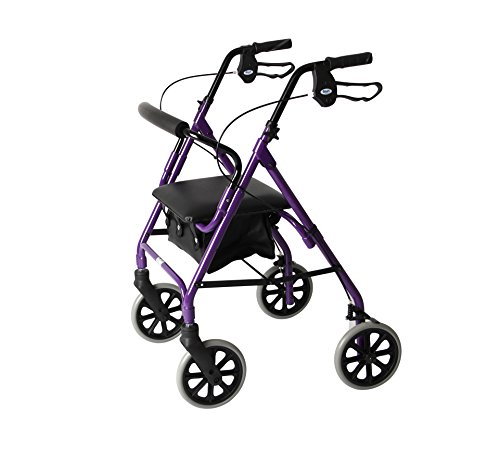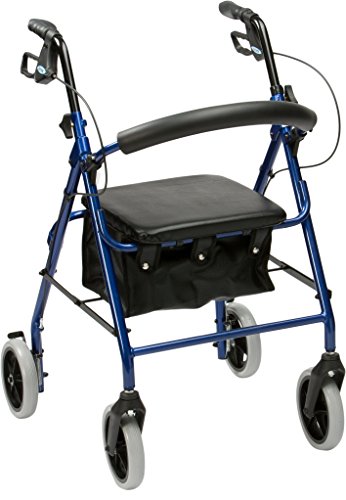Rollator Folding Tools To Ease Your Daily Lifethe One Rollator Folding Trick That Everyone Should Learn
작성자 정보
- Ramiro 작성
- 작성일
본문
 Locking Mechanism For Use With a Foldable Rollator
Locking Mechanism For Use With a Foldable RollatorAlmost all rollators have some kind of locking mechanism or latch to stop the rollators from being rolled out during storage. This is crucial to avoid the risk of a dangerous situation during transportation.
The lock is usually located near the center of the frame. It could be a lever or a button. It's important to know how to use this feature.
How to Fold a Rollerator
Rollators are highly efficient mobility aids for people who require stability and support when walking. Rollators are lightweight, practical and are available in a range of models that can be adapted to different budgets and requirements. 1. However, some users may be concerned about how to fold and unfold a rollator in order to make it safe to use.
Modern rollators come with easy-to-use mechanisms for folding. The walkers can be folded quickly without the use of any tools. This makes them perfect for storage and transport. Additionally the locking mechanism guarantees that the folded walker will not open during transport or storage thus ensuring safety and security for users.
Alongside a simple folding mechanism modern walkers have ergonomic designs that provide safety and comfort to the user. They come with a big basket, comfortable handles, and a brake lever that prevents accidental activation. In addition they are made from lightweight materials that ensure mobility and comfort.
Traditional rollators On the other hand are heavier and do not fold themselves making them difficult to transport or store. Their seats are also attached to the frame, so they can't be stored against objects or in narrow spaces. It is important that people who use rollators learn how to fold them for easier storage and transportation.
The first step to fold the rollator is to locate the locking mechanism, which is usually located near the center of the device's frame. Once you have located it then gently lift or let it go according to the manufacturer's instructions. When the locking mechanism has been removed, you can fold the walker by pushing its sides toward each one while holding the release. Continue doing this until the walker is fully folded and securely locked.
You should also inspect your walker to determine if there are any parts that are loose or indications of wear and damage. Repair any issues as soon as you notice them to prevent further injury or damage. In addition, it is recommended to regularly oil all moving parts of the walker in order to reduce friction and ensure smooth operation.
The Crossbar
The crossbar is the bar that supports a Rollator folding's frame and wheels. The crossbar is usually made of metal, and it connects the handlebars to the frame's bottom. The crossbar adds stability and strength and holds the basket of the walker and other accessories. Many manufacturers offer a variety of accessories that can be added to their walker models, such as storage baskets and tote bags. They can be positioned on the front or the back of the walker or placed under the seat.
Many models of walker have a crossbar which can be folded in two directions. This makes them more compact and easier to transport. This is a crucial feature, particularly if the walker will be frequently used for travel or long trips to the grocery store or other places. Additionally, certain models of walker come with a removable carry bag for additional storage space.
Another major characteristic of a rollator is the brakes, which are typically placed on the handles or crossbar. There are different types of brakes, including cable loop and push-down. The brakes that are push-down require the user to provide downward pressure to the spring-loaded frame in order to stop the walker from rolling. This kind of system may not be suitable for petite users who might struggle to engage the brakes, or heavier users who might unintentionally activate the brakes without knowing it.
The cable loop brake works similar to the brakes on bicycles. The cable loop brake system is activated by simultaneously pressing both handlebars using both hands. This type of brake system is better appropriate for people with limited hand function, and provides more control than brakes that push down.
Crossbar can also be a reference to a vertical stroke that crosses two other strokes within a letterform. The position, length and width of a crossbar will affect the accessibility of any letterform. This is a significant distinction between serif and non-serif fonts. The crossbar on the smaller e is often called an arm.
The Release Mechanisms
Rollators are a great way to boost mobility and independence for those who have physical limitations. These innovative stability aids redistribute the weight of the user evenly across their lower body, reducing strain to muscles and joints and allowing easy and comfortable movement. With customizable features like adjustable handlebars and handbrakes, built-in seats, and storage compartments, they make it easier for users to navigate their environment with comfort and confidence. These best lightweight rollator portable mobility aids are covered by Medicare and Medicaid to make them more affordable.
 As opposed to traditional walkers that come with a basket and a seat and must be stowed 2 in 1 rollator the trunk of your car carbon rollators fold down to allow to make it easy to transport them in your car or for compact storage. To do this, take the basket from the frame and pull up the crossbar. This will reveal pair of release mechanisms on either side. Press these release mechanisms while pushing the sides of the frame together until the walking aid shrinks to a smaller size.
As opposed to traditional walkers that come with a basket and a seat and must be stowed 2 in 1 rollator the trunk of your car carbon rollators fold down to allow to make it easy to transport them in your car or for compact storage. To do this, take the basket from the frame and pull up the crossbar. This will reveal pair of release mechanisms on either side. Press these release mechanisms while pushing the sides of the frame together until the walking aid shrinks to a smaller size.The locking assembly is attached to a top support arm that is substantially horizontal, 218 which joins two front and rear tubular legs that are largely vertical. Telescoping tubular leg extension 226 and 228 are fixed to the ends of front and rear tubular legs. The telescoping extension is able to be rotated from an unlocked to a locked position in order to adjust the height.
After the leg segments of the extension have been positioned in the right position, a nonsliding grip is positioned at the end of actuating lever. The actuating lever attaches to the housing using an extension piece that extends away from the frame, and a recessed portion dimensioned to accept the extension piece. The recessed portion and the extension piece serve as an axis on which the actuating lever can be pivoted.
Once the telescoping legs segments are in the proper position, the locking mechanisms engages a snap-button and biasing spring. This arrangement allows the user to simply engage or detach the folding mechanism, which allows for a simple storage and transport of the walking aid.
The Locking Mechanism
The present invention is a locking mechanism for use with an walker or rollator for tall people that folds. The invention addresses a need for a lock assembly for use with these walkers and rollators that is easy to adjust between folded and unfolded positions by those who be unable to move their hands.
Typically, the device that consists of two side frames and the cross brace connecting them is comprised of two handle bars. Two hand brakes are fixed on the handles. Each has a pin actuating plunger which is able to engage with the plunger on the respective cross bar. As the user presses the hand brakes, the pin actuating spout is depressed causing the side frame rotate into a folded state.
This kind of device has one issue: the actuating handle needs to be held by one hand, while trying to press the pin-actuating plunger. This can be problematic for persons with limited hand strength and/or dexterity. The present invention addresses this issue by incorporating a locking assembly that can be operatively linked to the actuator mechanism.
As shown in FIG. In FIG. A lock plate is set inside the bore and has an opening that can be adapted to receive a locking end of the locking pin. A portion of the actuating mechanism between the handle for force application end and the body attaching portion is configured to pivot relative to both of the body parts so that the locking pin can be moved from a fixed position that prevents rotation of the corresponding tubular leg to a second position where the leg extension that is telescoping can be extended.
When the actuating lever is moved by the hand of the user, the locking pin is moved from its initial position to the second. The leg extensions that telescoping can be extended and then rotated back into their folded position by turning the side frame. This can be done with the hand of the user still firmly gripping the handgrip 24 of the side frame. This feature can significantly reduce the amount of effort needed to fold a rollator into and out of its folded position.
관련자료
-
이전
-
다음
댓글 0
등록된 댓글이 없습니다.

